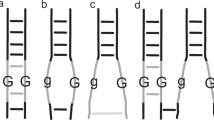Abstract
In autotetraploids, chromosome pairing may be in the form of quadrivalents or bivalent pairs. Whether or not the quadrivalents are maintained until first meiotic metaphase depends on the formation of chiasmata. The relative frequencies of M I configurations thus contain information both on pairing and on chiasma formation. With distal chiasma localisation six configurations can be recognised and their relative frequencies determined: ring quadrivalents, chain quadrivalents, trivalents (with univalent), ring bivalents, open (rod) bivalents, univalent pairs. These represent five degrees of freedom permitting five parameters to be estimated: the frequency (f) of quadrivalent pairing; the frequencies of chiasmate association of the two ends (arms in metacentrics), a′, b′, after quadrivalent pairing, and a, b after bivalent pairing. — The appropriate formulae have been derived and applied to observations on Tradescantia virginiana (4n=24) which has pronounced distal chiasma localisation. Slight modifications make the model applicable to autotetraploids with interstitial in addition to distal chiasmata. In T. virginiana, chromosome pairing appeared to be random between homologues (65.8% quadrivalent pairing; 55.4% observed at M I). After quadrivalent pairing chiasmate association is frequent in the “average long” arm (95.0%) and much less so in the other arm (60.5%). This is attributed to partner exchange. After bivalent pairing chiasma frequencies are still different for the two arms (93.8% and 83.5% association respectively) but much less pronounced. Various complications are discussed.
Similar content being viewed by others
References
Durrant, A.: Expected frequencies of chromosome association in tetraploids with random chiasma formation. Genetics 45, 779–783 (1960)
Sved, J. A.: Telomere attachment of chromosomes. Some genetical and cytological consequences. Genetics 53, 747–756 (1966)
Sybenga, J.: The calculation of the map length of interchange segments from meiotic configuration frequencies. Genetica ('s-Gravenhage) 41, 101–110 (1970)
Sybenga, J.: General cytogenetics. Amsterdam-London-New York: North-Holland/American Elsevier 1972
Sybenga, J., de Vries, J.M.: Chromosome pairing and chiasma formation in polysomic B-chromosomes in rye, Secale cereale. Biol. Zbl. 91, 181–192 (1972)
Author information
Authors and Affiliations
Rights and permissions
About this article
Cite this article
Sybenga, J. The quantitative analysis of chromosome pairing and chiasma formation based on the relative frequencies of M I configurations. Chromosoma 50, 211–222 (1975). https://doi.org/10.1007/BF00283241
Received:
Issue Date:
DOI: https://doi.org/10.1007/BF00283241




